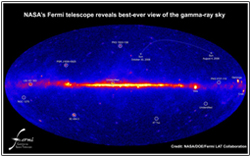Energy from the Center of the Milky Way May Be the Remnant of Dark Matter
Dark matter is the mysterious "stuff" which makes up the majority of the matter in our universe. It is called "dark" because we cannot yet see it or detect it directly. We know that it must exist because its mass causes gravitational effects which we can observe. Any object with mass causes gravitational attraction, similar to the way the earth's mass causes the attraction which holds you to the ground. The gravitational attraction of dark matter helps hold stars and gas within their galaxies. Based on the effects of gravity in our galaxy, scientists believe that there is a high concentration of dark matter near the galaxy's center, around the supermassive black hole which resides there.
For decades, scientists have been studying the activity at the galactic center and the various types of radiation that we receive from it. Astrophysicist Dan Hooper, supported by the U.S. Department of Energy and NASA, has analyzed data received by the Fermi Gamma-ray Telescope. He believes there is strong evidence that some of these gamma-rays come from the annihilation of dark matter particles.
When two particles "annihilate", both particles disintegrate into energy. That energy can take on a variety of forms, and in this case, part of it is emitted as gamma-rays. By studying the energy spectra of these gamma-rays, scientists can determine the masses of the annihilated particles.
Hooper has studied those gamma-rays, and he claims, "This is the most compelling evidence of dark matter's particle nature yet."
Some astrophysicists remain skeptical of Hooper's findings. They believe that the gamma-rays may have been produced by other sources, and that this is not direct evidence of dark matter. Some say that the gamma-rays may be emitted by spinning stars or perhaps some other source we have not thought of yet.
Seth Digel, physicist at the SLAC National Accelerator Laboratory and analysis coordinator for the Large Area Telescope, says "We feel that astrophysical interpretations for the gamma-ray signals from the region of the galactic center have to be further explored."
But Hooper is confident in his analysis. "We have shown in our paper that none of these other sources can account for the observed spectrum or the very highly concentrated nature of the signal. The more we study these gamma-rays, the harder it is to explain them with anything other than dark matter."
This is exciting news for scientists who continue on the quest to identify the mysterious form of matter. This peek at one of dark matter's properties gives hope and motivation for one day completely unveiling the hidden substance that permeates our universe. The details of Hooper's analysis can be found in his research paper, posted on the preprint server arxiv.org.
While astrophysicists look toward the sky in search of dark matter, others are trying to find it using particle colliders and underground detectors. The Tevatron at Fermilab and the Large Hadron Collider at CERN are two major particle accelerators which attempt to create dark matter from the energy of particle collisions. Scientists at the Cryogenic Dark Matter Search also attempt to detect dark matter with their ultra-sensitive underground detectors in California and Minnesota.
Identifying dark matter particles would be historically remarkable. But there would still be 73% of the mass-energy of the universe left in question. That 73% is known as dark energy, the power source driving the accelerated expansion of our universe. According to the standard model, about 13.7 billion years ago, the entire universe was born from an event known as the Big Bang. This event gave birth to all of the matter and energy that exists in the universe today. While the Big Bang set the universe in motion and initiated its expansion, we would expect that the gravitational attraction of all of the matter in the universe would now slow down the expansion. Instead, scientists observe that the universe is expanding at an increasing rate. They believe that it is dark energy which drives the expansion, but the nature of this dark energy is unknown. Both dark matter and dark energy remain among the top mysteries of the universe, key topics of astrophysical research today.
This article was written by Abigail Pillitteri



